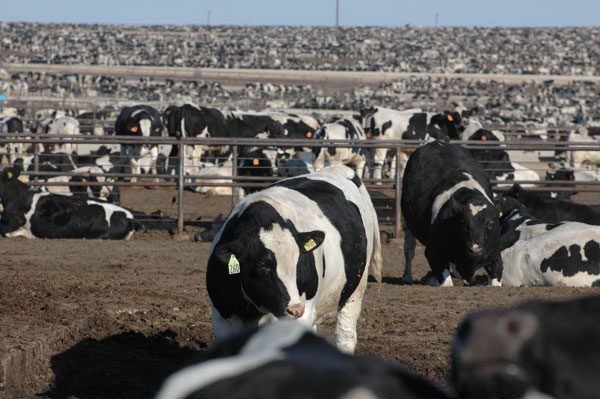Beef-on-dairy: Hitting the tipping point
While beef-on-dairy production has long been viable, it’s now becoming a regular part of the mix of cattle in the beef marketing chain.

Coming soon to a feedyard near you — F1 beef-dairy calves. No, wait. They’re already there. Have been for a while, in fact.
Now, however, we’ve reached the tipping point, says Don Close, senior protein analyst with Rabo AgriFinance. “Up to this point, breeding beef genetics onto dairy cows has largely been experimental,” he says. “But dairies and semen companies expect there will be a large increase in beef-on-dairy calves coming to market in 2020, with rapid transition over the next three to five years.”
Before you start worrying about how that will affect the price of your calves, remember that dairy steers, mostly Holsteins, have been fed for beef production for years. So this trend won’t significantly change the number of calves and feeders headed to a feedyard.
The way Close figures it, even if the trend reaches its full potential, “We’re talking around 2.94 million Holstein crosses, and we’re coming up with, like, 519,000 Jersey crosses. That’s compared with 31.3 million beef cows in the country. So there’s limitations on the size of how big this will ever be.”
What it will change is the quality and acceptability of those cattle.
For several reasons — such as the length of the carcass and configuration of the rib-eye — beef packers have long discriminated against dairy steers fed for beef production. In fact, Tyson quit buying Holstein steers a few years back.
Beef characteristics
But with an F1 beef-dairy steer, Close says it’s amazing how much that calf takes on the characteristics of a beef animal, especially its ability to grade upper two-thirds Choice and Prime.
That’s because — in part, at least — of the narrow genetics in the dairy business, especially the strong emphasis on butterfat production. “If you have an animal that can produce an increased level of butterfat, by default you have a propensity to lay down more intermuscular fat,” Close says.
Assume those F1 calves will finish from 1,350 to 1,450 pounds live weight — the same weight range of many beef steers. “They will grade in excess of 80% Choice. And they’re targeting 20% Prime with a SimAngus-Holstein cross.”
For the beef business, that genetic consistency and gradeability offers several advantages.
For the cattle feeder, the consistency of the cattle to put on pounds and grade is a big attraction. But just like any other calf, health is a huge factor in that equation. And that, potentially, is a rub. Here’s why.
Cultural differences
It boils down to differences in perceptions between a beef producer and a dairy producer, Close says.
“A cow guy, when he has a heifer calf born, he took a hit, because that steer calf is worth more than the heifer. When the dairyman has a heifer calf land on the ground, he just won the lottery — because in his world she’s worth a lot of money.”
That is a stumbling block, Close says. “They’re pretty quick to come to terms on the male calves, but that difference in psychology makes it more difficult for them to come to terms on the value of a heifer, just because they view them from opposite ends of the coin.”
Then there’s this: The dairy has always looked at male calves as a liability. “So, subsequently, a heifer calf is born; he’s pouring colostrum or milk replacer down that heifer like crazy. He’s given that male calf whatever’s left over, and he doesn’t want the added expense of pouring colostrum down that steer calf.”
However, just like a beef calf, sufficient colostrum is critical to getting the dairy calf off to a good start. As Close researched the advantages and disadvantages of a beef-dairy production system, everyone from the calf ranch to the feedyard said if the calf starts right, they’re a pleasure to feed.
“If you get a set of calves that weren’t given that additional care, they are a headache all the way through,” he says. “So while that dairyman is in line for an additional $100 to $150 premium on those male calves [above what a purebred dairy calf is worth], he’s also having to put more money in him, cause he’s going to have to put the colostrum and the care into that first 24 to 48 hours. So he’s got that added cost.”
Manageable hurdles
However, given the value proposition of breeding the majority of his dairy cows with beef semen, the small cost of managing that bull calf correctly isn’t a hurdle for the dairy producer. Changing the culture is.
But because of the value that a beef-dairy F1 calf has to a dairy producer facing a tough milk market, those hurdles can be cleared.
Plus, it adds value to more of the cattle a dairy produces. In the old days, a dairy would keep all its heifer calves, develop them and breed them. Those that conceived stayed in the milking herd, and those that didn’t were sold as nonfed beef animals.
Now, many dairies have identified the top 30% of their cows and breed them with sexed semen to produce their replacement heifers. The remaining 70% can be bred to a beef bull, and all the calves — steers and heifers alike — can be sold into the beef marketing chain.
Given the quality and consistency those calves bring to the bargain, they add value to the entire beef marketing chain.
That’s because the beef they produce is ideal for any number of branded beef programs — both here and for the export market.
And that’s a win-win for both cattle feeders and dairies, Close says.
About the Author(s)
You May Also Like


.png?width=300&auto=webp&quality=80&disable=upscale)
